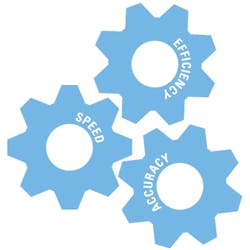Increasing lab excellence with three principles of peak performance
Health systems are undergoing a major transformation. They are being evaluated and inspected to ensure they’re running at peak performance. Weak links are being identified, and in today’s competitive healthcare industry weak links in a growing value-based healthcare environment are considered unacceptable. These transformative times make now more important than ever for clinical labs—some of which run well below capacity and efficiency—to maximize performance and increase their value.
Typically the lab represents at most five percent of a health system’s costs, but it is undeniably a critical link in the delivery of patient care, with 80 percent or more of each patient’s medical record flowing through the lab. A lab that’s running at peak performance—improving the continuum of patient care while showing increased efficiency—can offer a health system a much-needed competitive edge as care delivery options continue to expand in most communities.
To improve health system service and quality through lab operations, health systems must retain, optimize, and evolve their labs. This means keeping the lab in-house, rather than divesting—and investing—in processes and technologies that drive higher quality, better service, and demonstrable value. Broadly, this can be achieved by employing three principles of lab excellence: operate with speed, operate with accuracy, and operate with efficiency.
Sounds like a no-brainer, right? The trick is finding a balance among these practices. They must all work together in harmony, and none can be compromised, or the overall results will suffer greatly. As more than 3.5 billion tests are annually processed through health system-based clinical labs, not finding that balance is at the core when labs run into problems, and, via a domino effect, threatens the health system’s capacity and efficiency.
Speed
Data-driven operational intelligence and insights help speed real-time decision making in the clinical lab and foster best practices at their point of need. For example, visibility and transparency into the processing of a specimen from collection to result is critical. Ensuring everything from accurate specimen labeling, to reliable logistics, to an optimized process in the lab ultimately enables turnaround time. From the clinician’s perspective, this is what enables him or her to deliver a patient’s diagnosis and begin care faster.
In many cases, in-house testing services enable speed to decision, through support of broad test menus which reduce send-outs. When tests are sent to external labs, additional points of failure outside the control of the health system are introduced, which can result in delays in getting results to doctors.
Accuracy
Of course, accuracy is crucial to patient care, and inaccurate lab results are likely to be detrimental to a patient and have major cost and efficiency implications for a health system. An error in a test order entry can immediately render everything subsequent in the testing process—specimen collection, processing, resulting, and reporting—meaningless if not corrected. Each of these stages depends on the accuracy of the preceding one. A lab’s accuracy is the foundation on which speed and efficiency can be improved, not the other way around.
By maintaining an in-house lab, health systems can manage and tailor their testing capability to meet their specific needs, further ensuring control and accuracy of quality. And successfully coupled with speed, labs can further increase physician satisfaction and reduce the amount of time to patient diagnosis and treatment, improving the patient experience and the health system’s overall value and efficiency.
Efficiency
A comprehensive approach to people, process, and technology in the lab that optimizes and modernizes operations helps to achieve measurable improvements in efficiency. All areas of the lab, from the bench to supplies and test menu, must be examined carefully to uncover inefficiencies.
For example, lab test menus continue to evolve and expand as testing technologies advance, challenging health systems to respond and adapt accordingly. A lab must have strategies in place for test menu optimization and utilization, as they are key drivers of lab efficiency. Continual monitoring of lab tests ensures the right mix of local and reference testing.
Efficiency must work in tandem with speed and accuracy. The right tests must be performed and run quickly, and the lab must provide accurate results.
Conclusion
So, how can we tell we’re improving on all fronts—speed, accuracy, and efficiency? Incorporating performance standards and benchmarks that gauge lab quality and service is an important starting point for measuring a lab’s effectiveness beyond the dollars. Then, understanding the cost stack will provide the greatest insight into opportunities and focus.
The lab is a critical hub of the patient care continuum, yet it is an aspect of the healthcare system that is often overlooked. By leveraging the best approaches to performance management, the lab can save health systems a significant amount of money while accelerating lab performance to the highest standards of operational excellence. This is the best way to ensure the unity of speed, accuracy, and efficiency—strengthening a key link in the chain of care that saves a health system money, while providing an immense benefit to communities it serves.


